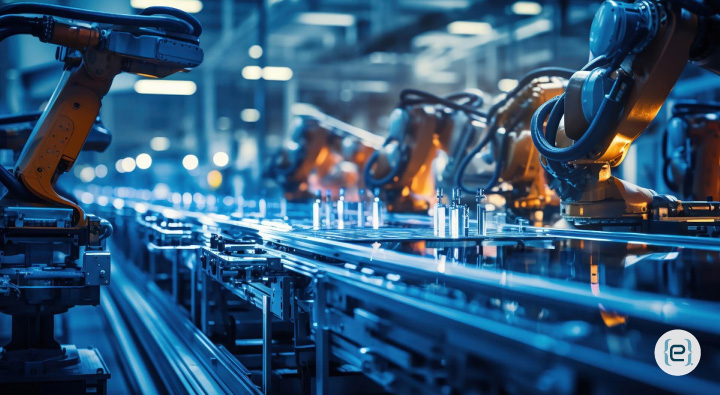When the Assembly Line Goes Dark: Hard Truths About IT in Modern Manufacturing


Last month, I watched a $50 million manufacturing operation grind to a halt because of a single server failure. Just one server. The plant manager’s face turned several interesting shades of red as he calculated the losses—roughly $27,000 per hour of downtime. Of course, this disaster was avoidable. If only they’d invested in proper IT infrastructure instead of running critical systems on hardware older than my nephew.
That incident got me thinking about all the manufacturing facilities I’ve visited over the past decade. The thriving ones, the struggling ones, and those that have vanished. Want to guess what separated the winners from the losers? Nine times out of ten, it came down to their IT backbone.
The Wake-Up Call: Technology’s Growing Role in Manufacturing
Remember Y2K? That was manufacturing’s first real wake-up call about IT infrastructure. Everyone panicked about machines stopping at midnight. While the fear was overblown, it forced companies to take a hard look at their technology dependence. Fast forward to today, and that dependence has grown exponentially.
Just last week, I toured a “smart” factory in Ohio. The plant manager proudly showed me their network operations center—a glass-walled room that looked more like NASA than a manufacturing facility. Screens everywhere displayed real-time data from thousands of sensors, machines, and processes. The whole operation hummed with efficiency. Five years ago, this same facility was running on Excel spreadsheets and paper forms. The transformation was remarkable.
The Real Cost of Cutting Corners on IT Infrastructure
Here’s something that keeps me up at night: watching manufacturers try to run modern operations on outdated IT infrastructure. It’s like watching someone try to deliver Amazon-level service using a horse and buggy. Sure, you might get there eventually, but your competitors will eat your lunch while you’re still loading the cart.
Take the story of an automotive parts manufacturer I worked with. They thought they were saving money by maintaining legacy systems instead of upgrading. Their competitors implemented modern IT infrastructure and started offering real-time order tracking, automated quality control, and predictive maintenance. Within two years, our horse-and-buggy friends lost 30% of their market share. That “cost-saving” decision cost them millions.
If you’re wondering how to drive innovation and stay competitive, investing in IT is not optional—it’s essential.
The Hidden Heroes: Redundancy and Resilience
Behind every successful manufacturing operation, there’s an IT infrastructure that nobody sees until it breaks. It’s like oxygen—you don’t think about it until it’s not there, and then it’s all you can think about. I’ve seen entire production lines shut down because a switch failed or a backup system wasn’t properly configured.
- Redundant Systems: One plant I visited had an IT director—let’s call him Mike—who fought for redundant everything: power, internet, servers. The CFO thought he was paranoid. Then a construction crew cut their main fiber line. While other businesses in the area went dark, Mike’s facility barely hiccupped as it switched to its backup connection. That “unnecessary” redundancy paid for itself in about four hours.
- Proactive IT Support: If you want to avoid costly downtime, consider 24/7 IT support to keep your systems running smoothly.
The Security Nightmare: Manufacturing as a Cyber Target
Here’s my controversial opinion: most manufacturers are living in a fantasy world when it comes to cybersecurity. They think they’re not targets because they’re “just making widgets.” Meanwhile, I’ve watched sophisticated attacks target everything from small machine shops to massive auto plants. Modern manufacturing IT infrastructure isn’t just about keeping the machines running—it’s about keeping the bad guys out.
Last year, a medium-sized electronics manufacturer got hit with ransomware. Their IT infrastructure was so outdated that their backup systems were connected to the same network as everything else. When the attack hit, it encrypted everything—production systems, quality control, and yes, all the backups. Three weeks of downtime later, they finally got back online. The total cost? Let’s just say it would have paid for a world-class IT infrastructure upgrade several times over.
If your facility hasn’t reviewed its security and privacy protocols lately, now is the time.
The Integration Challenge: Making Systems Work Together
The trickiest part about manufacturing IT infrastructure isn’t the individual components—it’s making everything work together. I recently watched a system integrator try to get a modern IoT sensor network to talk to a legacy ERP system. It was like watching someone try to teach their grandmother to use TikTok—technically possible, but painful for everyone involved.
- Integration Layers: Smart manufacturers are building their IT infrastructure with integration in mind from the ground up. One aerospace components manufacturer I work with has a dedicated integration layer in their IT architecture. Any new system or machine has to interface with this layer, not directly with other systems. It’s like having a universal translator for manufacturing technology.
- Cloud Solutions: Consider leveraging cloud-driven manufacturing for seamless integration and scalability.
The Human Factor: Training and Culture
Here’s something nobody talks about enough: the best IT infrastructure in the world is useless if your people can’t or won’t use it. I’ve seen million-dollar systems gathering dust because nobody trained the workforce properly. The smart companies? They invest in their people as much as their technology.
A food processing plant I visited runs regular “disaster games”—simulated IT failures that staff have to respond to. It’s like fire drills, but for technology. The first time they ran one, it was chaos. Now? Their team can handle most IT emergencies without even calling in the experts. That’s what good infrastructure combined with good training looks like.
The Future-Proofing Challenge: Building for Tomorrow
The pace of technological change in manufacturing is relentless. That shiny new system you just installed? It’s probably outdated before you finish configuring it. The key is building an IT infrastructure that can evolve. Think modular systems, scalable architecture, and standardized interfaces.
- Modular Design: One textile manufacturer I know builds their IT infrastructure like they’re playing with LEGO blocks. Every component has to be replaceable without bringing down the whole structure. When new technology comes along, they can swap out pieces without rebuilding everything from scratch. Smart, right?
- Strategic Planning: Learn how to future-proof your manufacturing IT with scalable, adaptable solutions.
The Bottom Line: IT Infrastructure Is Survival-Critical
After seeing countless manufacturing operations up close, I know that strong IT infrastructure isn’t just important—it’s survival-critical. The manufacturers who get this are thriving. The ones who don’t? There’s probably a “For Lease” sign on their building now.
The good news is, building robust IT infrastructure isn’t rocket science. It’s careful planning, smart investment, and a commitment to doing things right instead of doing them cheap. The bad news? If you’re not already working on this, you’re probably falling behind.
So, the next time someone asks you why manufacturing IT infrastructure matters, tell them this: in today’s world, your IT backbone is just as important as your production line. Because when it fails, everything fails. And in manufacturing, failure isn’t just expensive—it’s existential.
Ready to strengthen your manufacturing operation with robust, future-proof IT infrastructure? Contact eMazzanti today to discover how we can help your business stay ahead, secure, and resilient.
Recent Posts
Step Up Your Threat Response With Security Copilot
As we move deeper into 2025, you are probably focusing on ways to expand your…
Watch Out for the Cyber Security Menace
As we move deeper into 2025, you are probably focusing on ways to expand your…
The Rise of AI Agents: Simplifying Tasks and Connecting Technologies
Introducing eCare Bot: Your Intelligent IT Support Assistant In today's fast-paced world, the emergence of…
Server Simplified
At eMazzanti Technologies, we recognize that stable, effective, and expandable servers are essential to the seamless operation of enterprises. For this reason, we collaborate with Hewlett Packard Enterprise (HPE) to offer our clients the best server solutions possible, customized to meet their unique requirements. HPE servers provide the performance and flexibility required for small and big businesses to manage data, support apps, and manage workloads with ease. Customers may choose the best HPE servers for their organization with the assistance of our team of specialists. We take the time to comprehend the particular needs of every client, including those related to processing speed, storage capacity, and security features. Whether our clients require a general-purpose ProLiant server or a…
How to Make Your AI Copy Sound Authentic: Writing Like a Human, Not a Machine
AI writing tools have become popular for creating content quickly. But many readers can spot…
Data Analytics for Old-School Business Owners: Turning Dusty Ledgers into Gold Mines
Data analytics is changing the game for businesses of all types, including old-school industries that…


